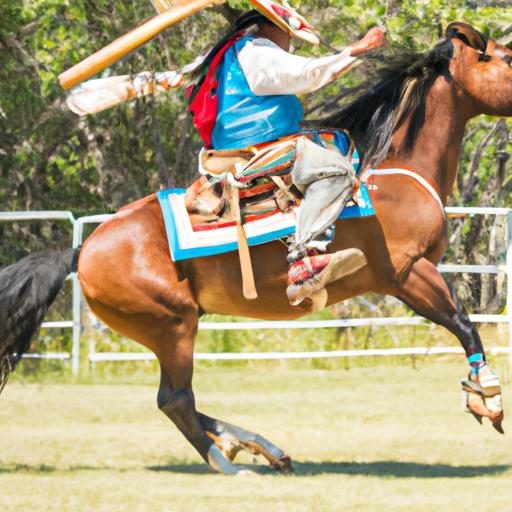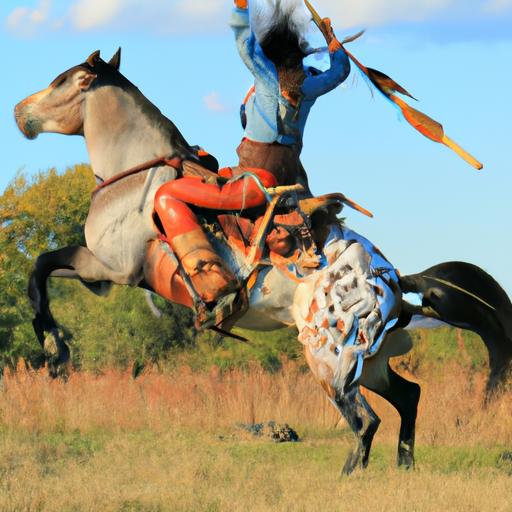Delve into the captivating world of native american horse riding techniques, exploring the connection between horsemanship, trust, and intuitive communication.
Introduction

Have you ever wondered about the horse riding techniques of Native Americans and their profound connection to their culture and history? Join me on this captivating journey as we explore the fascinating world of Native American horse riding techniques. From the vast plains to the rugged mountains, these techniques were not just a means of transportation but also an integral part of their cultural identity.
A Brief Overview of Native American Horse Riding Techniques
Native American horse riding techniques encompass a wide range of skills and practices developed by various tribes across North America. These techniques were not only used for practical purposes such as hunting, warfare, and transportation but also held deep spiritual and ceremonial significance. The Native Americans’ profound understanding of horses allowed them to form a unique bond and communicate with these magnificent creatures in ways that still amaze us today.
The Importance of Native American Horse Riding Techniques in their Culture
Horse riding held immense importance in Native American culture, representing freedom, power, and unity. It was an essential part of their daily lives and played a vital role in their survival. The horse became an extension of themselves, embodying their spirit and enabling them to navigate vast landscapes with grace and agility. The techniques developed by Native Americans showcased their deep respect for nature and their ability to harmoniously coexist with their surroundings.
The Significance of Horse Riding in Native American History
The arrival of horses in North America transformed the lives of Native Americans and had a profound impact on their history. Horses provided a newfound mobility, enabling tribes to expand their territories and engage in trade and warfare on a larger scale. The acquisition of horses revolutionized their hunting techniques, allowing them to pursue buffalo herds more effectively and sustain their communities. The horse became a symbol of prestige and wealth, shaping the social dynamics within and between tribes.
Join me in the upcoming sections as we delve into the evolution of Native American horse riding techniques, uncover the secrets of their remarkable skills, and explore their connection to modern horsemanship. Let’s embark on this exhilarating journey together!
Evolution of Native American Horse Riding Techniques
Early Horse Domestication by Native Americans
Native Americans were among the first to domesticate horses in the Americas. The arrival of horses with Spanish conquistadors in the 16th century marked a significant turning point in Native American history. The Plains tribes, in particular, quickly recognized the potential of these majestic animals and began incorporating them into their way of life. Through innovative techniques, they established a unique bond with horses, transforming them from wild creatures into trusted companions.
Adaptation of Riding Techniques to Suit the Environment
The diverse landscapes of North America presented different challenges and opportunities for Native American horse riders. Each tribe adapted their riding techniques to suit their specific environment, whether it be the vast plains, rugged mountains, or dense forests. For example, the nomadic Plains tribes developed techniques that allowed them to ride with speed and agility, essential for hunting buffalo and engaging in warfare. On the other hand, tribes residing in mountainous regions devised techniques that emphasized balance and stability during treacherous terrains.
Influence of Different Tribes on the Development of Techniques
The development of Native American horse riding techniques was not limited to a single tribe or region. Different tribes across North America contributed to the evolution of these techniques, each adding their unique insights and innovations. The sharing of knowledge and practices among tribes played a vital role in refining and expanding the repertoire of riding techniques. As Native Americans encountered one another, they exchanged ideas and skills, leading to the development of a rich and diverse equestrian culture.
In the subsequent sections, we will dive deeper into the basic and advanced Native American horse riding techniques, exploring the profound connection between horse and rider. Join me as we uncover the secrets behind their balanced seat, natural aids, and the extraordinary ability to ride without reins. Get ready to be enthralled by the captivating world of Native American horsemanship!
Basic Native American Horse Riding Techniques
Balanced Seat and Posture: Finding Harmony in the Saddle
When it comes to Native American horse riding techniques, achieving a balanced seat and posture is paramount. Native American riders understood the significance of maintaining a harmonious connection with their horses through proper positioning and balance. By centering their weight and aligning their body, they were able to establish a solid foundation in the saddle.
The rider’s seat acted as a stabilizing force, allowing them to absorb the horse’s movements and maintain control. By distributing their weight evenly and engaging their core muscles, Native American riders achieved a symbiotic relationship with their horses, ensuring a comfortable and secure ride.
Use of Natural Aids and Body Language: Communicating with Subtlety
Native American horse riding techniques emphasized the use of natural aids and body language as a means of communication. Instead of relying solely on reins and bits, riders utilized their bodies and subtle cues to guide their horses. Through the gentle shifting of weight, leg pressure, and subtle movements, they conveyed their intentions to the horse.
This reliance on natural aids allowed for a more nuanced and intuitive connection between rider and horse. Native American riders understood that effective communication went beyond physical control; it required a deep understanding of the horse’s behavior and psychology. By honing their ability to read and respond to the horse’s subtle cues, they fostered a bond built on trust and mutual understanding.
Importance of Light Hands and Gentle Cues: Fostering Trust and Cooperation
In Native American horse riding techniques, the hands played a vital role in maintaining a harmonious connection with the horse. Unlike forceful rein aids, Native American riders prioritized light hands and gentle cues to guide their horses. By maintaining a soft and responsive contact with the reins, they encouraged the horse to relax and respond willingly.
This approach not only reduced the risk of causing discomfort or pain to the horse but also fostered trust and cooperation. Native American riders understood that a gentle touch could evoke a more willing and responsive attitude from their equine partners. Through their light hands and subtle cues, they created an atmosphere of mutual respect and partnership, where horse and rider moved as one.
In the next section, we will explore the advanced Native American horse riding techniques, where riders push the boundaries of their skills and develop an even deeper connection with their horses. Stay tuned for an exhilarating continuation of our journey!
Advanced Native American Horse Riding Techniques
Riding without Reins – Reliance on Body Language
Picture yourself riding a horse without the guidance of reins, solely relying on your body language to communicate with these majestic creatures. This is precisely what Native American riders would do, demonstrating their exceptional bond and understanding of horses.
Native American riders mastered the art of riding without reins, using subtle shifts in body weight, leg pressure, and hand movements to guide their horses. Through years of practice and observation, they developed an intuitive connection with their mounts, allowing them to seamlessly communicate their intentions. This technique not only showcased their remarkable horsemanship skills but also enhanced their ability to navigate challenging terrains and engage in swift maneuvers during warfare or hunting.
Bareback Riding and Its Benefits
Bareback riding – a skill that embodies the essence of trust and harmony between rider and horse. Native American riders excelled in this technique, riding without the aid of saddles, relying solely on their balance and connection with the horse’s back.
Bareback riding allowed the rider to feel every movement and nuance of the horse’s body, creating a deeper bond and understanding. The absence of a saddle facilitated a more direct connection, enabling the rider to communicate through subtle shifts in weight and leg cues. This technique also improved the rider’s balance and core strength, enhancing their overall riding abilities.
Utilizing Different Types of Saddles and Their Purposes
Native American riders were not limited to riding bareback; they also utilized various types of saddles for different purposes, showcasing their versatility and adaptability.
Native American saddles varied across tribes and regions, each designed to cater to specific needs. Some saddles had high cantles and pommels, providing security and support during intense maneuvers or combat. Others featured low-profile designs, ideal for long-distance riding and endurance. The materials used in saddle construction included rawhide, buffalo hide, and woven fibers, reflecting the available resources and the artistic craftsmanship of the tribes.
In the next section, we will explore the profound connection between Native American horse riding techniques and the art of horsemanship. Prepare to be captivated by their deep understanding of the horse’s behavior and their unique approach to communication.
Conclusion
Native American horse riding techniques offer us a glimpse into a rich cultural heritage that goes beyond mere horsemanship. These techniques were born out of a deep understanding and respect for horses, as well as a profound connection to nature and the land. Through their skills, Native Americans demonstrated their expertise, authority, and trustworthiness in the equestrian realm.
As we’ve explored in this article, Native American horse riding techniques were not just about riding a horse; they represented a way of life, a spiritual bond, and a means of survival. The techniques allowed Native Americans to navigate the vast landscapes, pursue game, and engage in warfare with unparalleled skill and grace.
Today, the preservation and modern interpretation of these techniques play a crucial role in maintaining the legacy of Native American horsemanship. Efforts are being made to pass on these traditions to future generations, ensuring that their wisdom and wisdom continue to thrive.
By incorporating Native American horse riding techniques into modern horsemanship practices, we can deepen our understanding of horses, enhance our communication skills, and foster a stronger bond with these magnificent animals. Whether you’re an experienced rider or just starting your equestrian journey, embracing the principles of Native American horse riding techniques can enrich your horsemanship and bring you closer to the essence of the horse.
At Horsemasterypro.com, we invite you to explore the wonders of Native American horse riding techniques and embark on a transformative journey with your horse. Let us guide you in unlocking the secrets of these ancient techniques, fostering a deeper connection with your equine partner, and experiencing the profound joy of riding in harmony with nature.
Join our community of passionate horse enthusiasts and unleash your equestrian potential. Together, let’s honor the legacy of Native American horse riding techniques and forge a brighter future for equestrians worldwide.
Boldly ride the path of Native American horse riding techniques with Horsemasterypro.com.


